人教版(2019) 必修第二册 Unit 4 History and Traditions American History课件(85张ppt)
文档属性
| 名称 | 人教版(2019) 必修第二册 Unit 4 History and Traditions American History课件(85张ppt) | 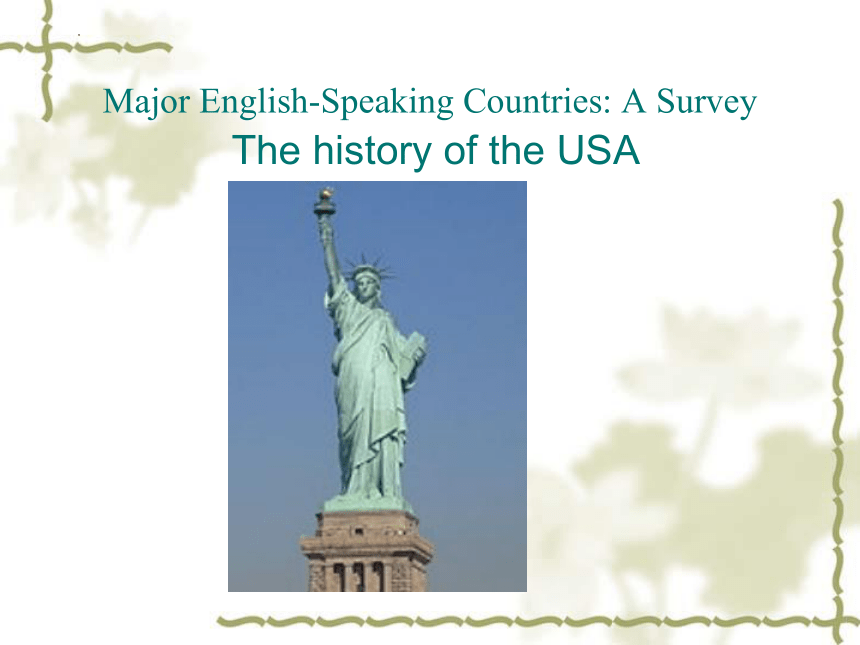 | |
| 格式 | pptx | ||
| 文件大小 | 3.8MB | ||
| 资源类型 | 教案 | ||
| 版本资源 | 人教版(2019) | ||
| 科目 | 英语 | ||
| 更新时间 | 2022-11-01 07:21:55 | ||
图片预览

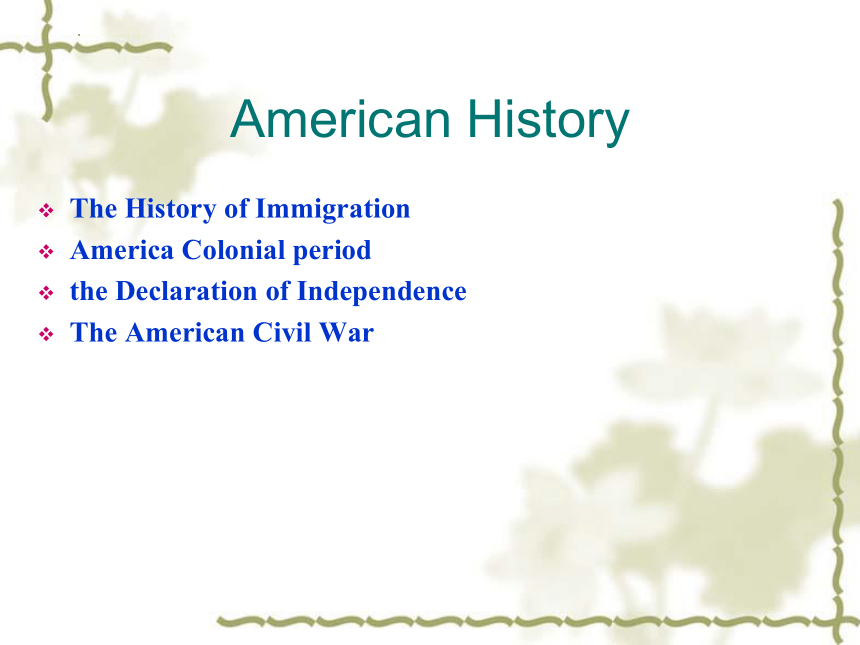
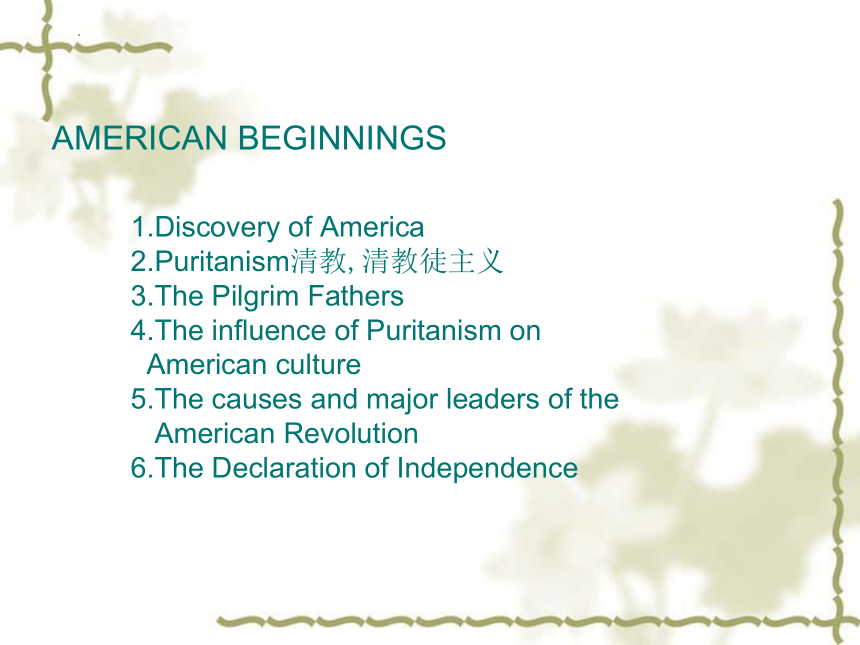
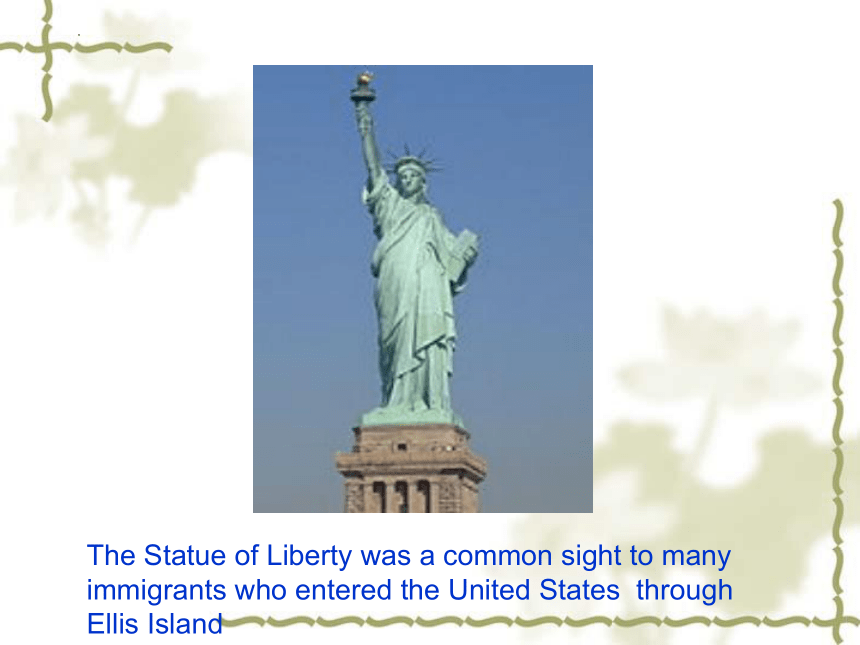

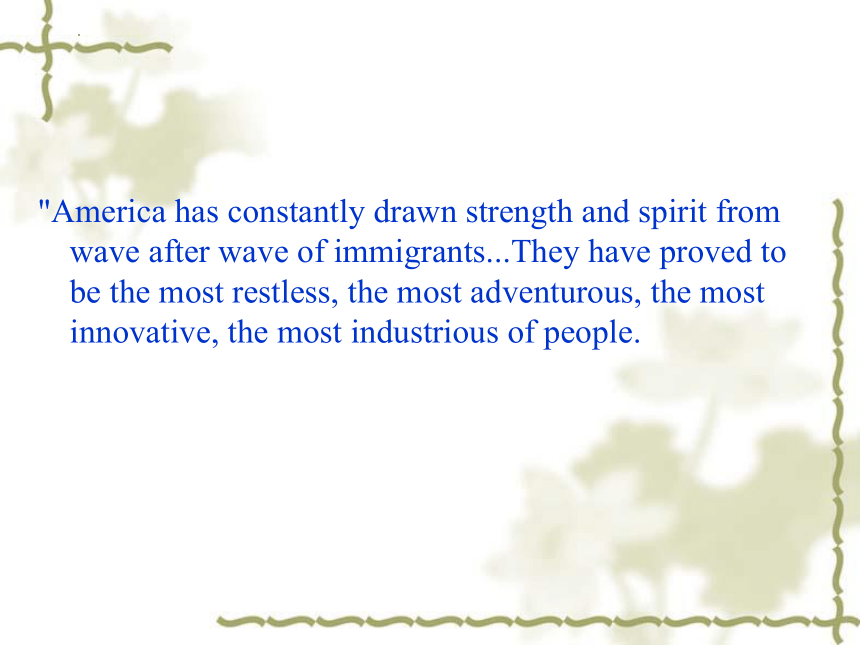
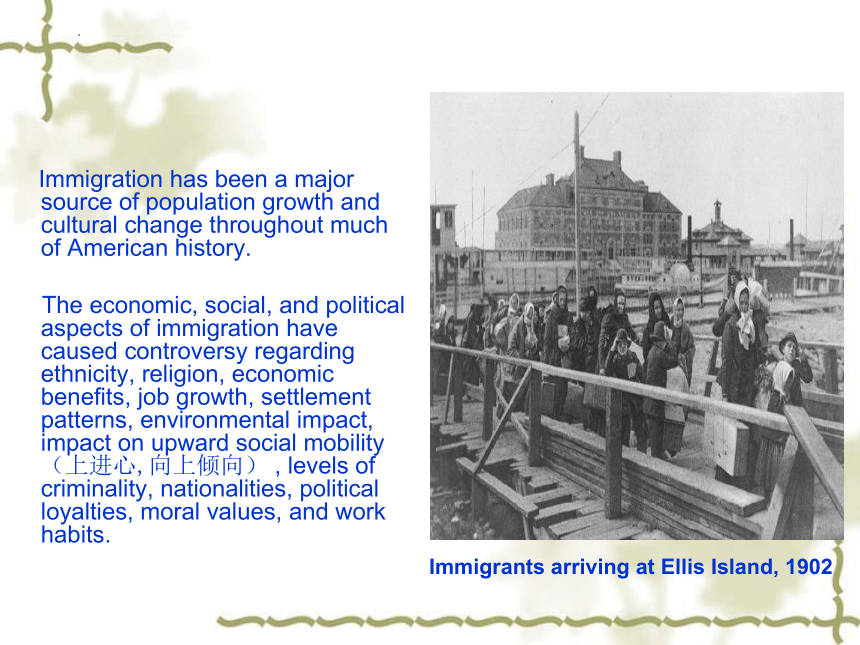
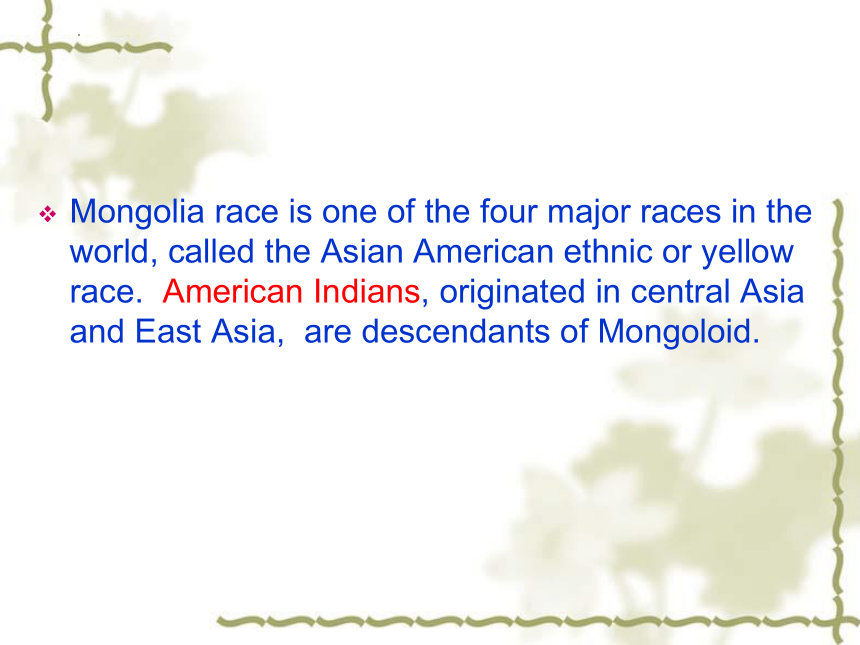
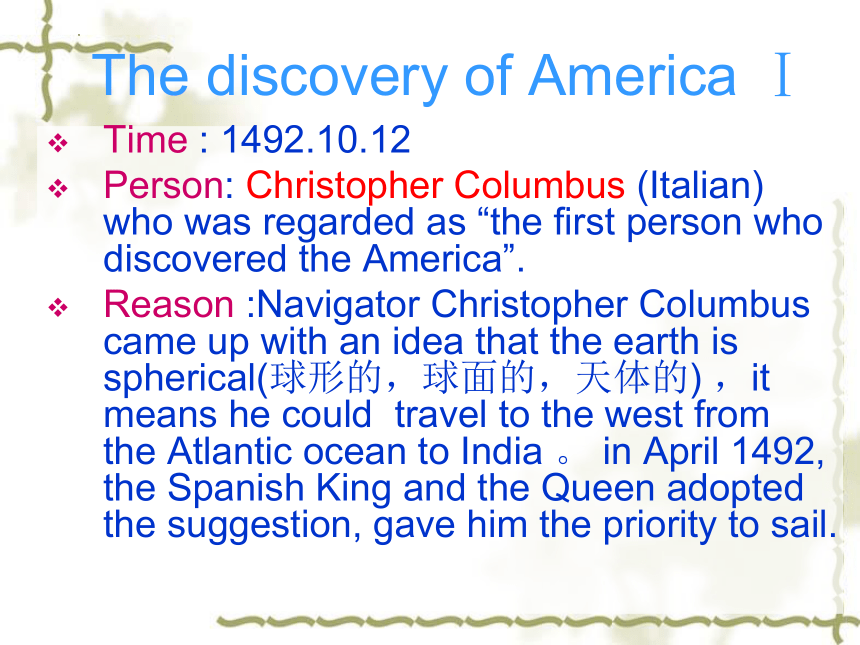
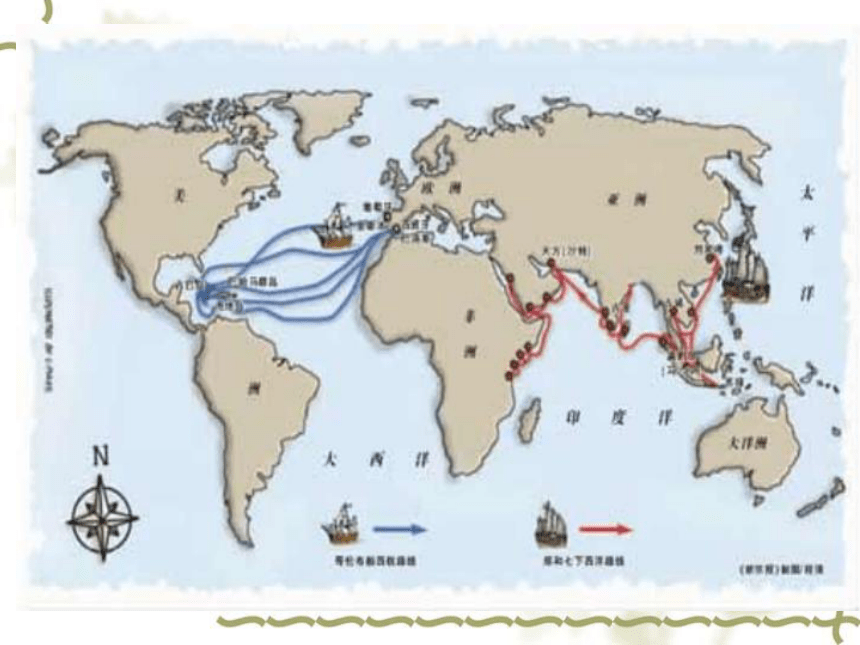

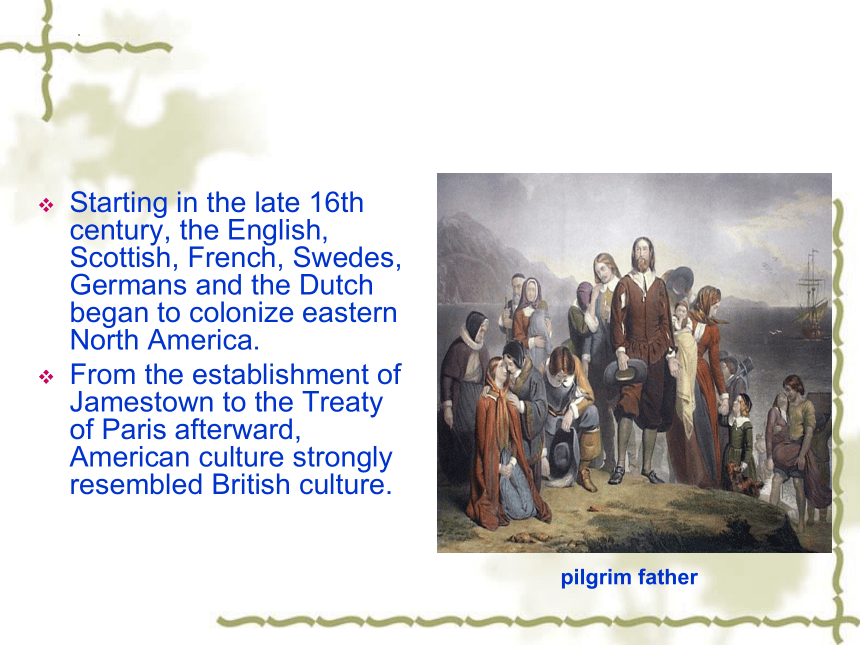
文档简介
(共85张PPT)
Major English-Speaking Countries: A Survey
The history of the USA
American History
The History of Immigration
America Colonial period
the Declaration of Independence
The American Civil War
AMERICAN BEGINNINGS
1.Discovery of America
2.Puritanism清教,清教徒主义
3.The Pilgrim Fathers
4.The influence of Puritanism on
American culture
5.The causes and major leaders of the
American Revolution
6.The Declaration of Independence
The Statue of Liberty was a common sight to many immigrants who entered the United States through Ellis Island
The History of Immigration
At the 1998 commencement address(毕业典礼) at Portland(波特兰,美国俄勒冈西北部港市) State University, U.S. president Bill Clinton voiced support for immigrants, including immigrants from Asia and Latin America when he said that:
"America has constantly drawn strength and spirit from wave after wave of immigrants...They have proved to be the most restless, the most adventurous, the most innovative, the most industrious of people.
Immigration has been a major source of population growth and cultural change throughout much of American history.
The economic, social, and political aspects of immigration have caused controversy regarding ethnicity, religion, economic benefits, job growth, settlement patterns, environmental impact, impact on upward social mobility(上进心,向上倾向) , levels of criminality, nationalities, political loyalties, moral values, and work habits.
Immigrants arriving at Ellis Island, 1902
Mongolia race is one of the four major races in the world, called the Asian American ethnic or yellow race. American Indians, originated in central Asia and East Asia, are descendants of Mongoloid.
The discovery of America Ⅰ
Time : 1492.10.12
Person: Christopher Columbus (Italian) who was regarded as “the first person who discovered the America”.
Reason :Navigator Christopher Columbus came up with an idea that the earth is spherical(球形的,球面的,天体的) ,it means he could travel to the west from the Atlantic ocean to India 。 in April 1492, the Spanish King and the Queen adopted the suggestion, gave him the priority to sail.
Voyage Condition:
1. The invention of compass
2. The development of shipbuilding
3. Economic foundation
4. The support of the Spanish Royal
5. The development of the capitalism
The four voyage time : 1492~1493, 1493~1496, 1498~1450, 1502~1504
Achievement:
1. reached the islands of the Caribbean;
2. established the first colony in America;
3. Found some gold and row materials;
4. established the slavery;
Amerigo Vespucci(阿美利哥维斯普齐)
Voyage time: 1499~1502
Achievement: discovered the South America
Process: From 1499 to 1501, Amerigo attended the voyage and reached the coast of Guyana. Amerigo sailed to the south, found the Amazon river estuary(河口), discovered the Trinidad and the Orinoco, back to Spain via(经过) the Dominican republic.
Starting in the late 16th century, the English, Scottish, French, Swedes, Germans and the Dutch began to colonize eastern North America.
From the establishment of Jamestown to the Treaty of Paris afterward, American culture strongly resembled British culture.
pilgrim father
The colonists were building a new way of life in the New World. There were a number of features which would play a role in forming the American character.
They were :representative of government, rule of law, respect of individual rights, religious tolerance and a strong spirit of individual enterprise.
America Colonial period
In 1607, some 100 men and boys sailing from England landed in present-day Virginia and founded Jamestown,the first permanent British settlement. It later grew into the Virginia colony.
Inspired by the success of Spanish explorers who had found gold in South America, these adventurers hoped to get rich. The English merchants who organized the Jamestown colonists expected prosperity or wealth from the venture. They were particularly interested in sources of gold.
Not finding great fortune and treasures, the colonists began growing tobacco by 1612 for shipment back to England. Tobacco provided a steady economic base for the young settlement.
Detail from a painting by American artist Benjamin West ,
which depicts William Penn's treaty with
the Native Americans living where he founded the colony of Pennsylvania as a haven for Quakers and others seeking religious freedom. (Courtesy The Pennsylvania Academy of Fine Arts)
Another settlement occurred in 1620 when the Puritans, English Protestants,traveled across the Atlantic Ocean on the Mayflower.
Pilgrims signing the Mayflower Compact aboard ship, 1620. (Library of Congress)
They landed in New England and established the Plymouth settlement. Also known as Pilgrims, they came to America seeking religious freedom rather than economic gain.
Before they set foot on the new land, the Pilgrims signed the Mayflower Compact, in which they promised to obey the rules and laws of the colony.
By the 1760s, England and its 13 American colonies were quarreling over settlement, government, and taxes, especially those imposed by the Stamp Act(印花税法案) of 1765.
1.2 Boston Tea Party
The independence of the Massachusetts colonial government was curtailed, and more British soldiers were
sent to the Port
of Boston.
In 1773, patriots staged the “Boston Tea Party” in
response to the tea tax.
British Parliament then passed The Intolerable Acts:
They boarded British merchant ships and tossed 342 crates of tea into Boston harbor.
Finally, in 1775, skirmishes(小规模战斗;小冲突 )broke out in Lexington and Concord, Massachusetts.
In 1776, Thomas Paine(托马斯·潘恩 ) rallied colonists with a pamphlet called Common Sense, It argued for independence from British rule.
The Declaration of Independence drafted by Thomas Jefferson of Virginia.
The Declaration is a clear explanation of the political theory behind the revolution and this theory came from the British philosopher John Locke.
《独立宣言》是由托马斯。杰文逊起草的,它明确阐述了支撑这场革命的政治理论,这一理论来源于英国著名哲学家约翰。洛克。
Over the next five years, General George Washington led the Americans against the British.
In 1783. England officially recognized American independence in the Treaty of Paris, negotiated by Benjamin Franklin and others.
1783年9月簦订《巴黎和约》,英正式承认美国独立。
the Declaration of Independence
The United States Declaration of Independence is a statement adopted by the Second Continental Congress on July 4, 1776, which announced that the thirteen American colonies then at war with Great Britain were now independent states, and thus no longer a part of the British Empire.
The Declaration Stated:
“We hold these truths to be self-evident, that all men are created equal, that they are endowed by their Creator with certain inalienable rights, that among these are Life, Liberty, and the pursuit of Happiness.”
我等之见解为:下述真理不证自明
:凡人生而平等,秉造物者之赐,拥诸无可转让之权利,包含生命权、自由权、与追寻幸福之权(原意为:拥有私人资产之权)。
THE AMERICAN CIVIL WAR
The Civil War: Union vs Confederacy
Confederate Union
Eleven Southern slave states declared their secession退出, 脱离 from the United States and formed the Confederate States of America美国南部邦联 (the Confederacy).
Led by Jefferson Davis, they fought against the United States (the Union), which was supported by all the free states and the five border slave states. Union states were loosely referred to as "the North".
The Republican victory in that election resulted in seven Southern states declaring their secession from the Union even before Lincoln took office on March 4, 1861. Both the outgoing and incoming US administrations rejected the legality of secession, considering it rebellion .
Cause No. 2: Abolitionism
Harriet Beecher Stowe
So this is the lady who started the Civil War.
-- Abraham Lincoln
Sold 300,000 copies in
the first year.
2 million in a decade!
Emancipation Proclamation解放奴隶宣言
It freed the slaves only in states that have seceded from the Union.
It did not free slaves in border states.
1863
Emancipation = freedom
Lincoln met with his cabinet on July 22, 1862 for the first reading of a draft of the Emancipation Proclamation
Gettysburg – Turning Point
Gettysburg is the largest battle in the history of the Western hemisphere.
Over 100, 000 people died in 3 days.
It was the last time the South invaded the North.
Battle of Gettysburg
Gettysburg Address
On November 19,1863,Abraham Lincoln made a short speech on the occasion of dedicating the national cemetery at Gettysburg. He ended his speech with these memorable words:" That government of the people ,by the people, for the people, shall not perish from the earth.
Four score and seven years ago our fathers brought forth on this continent a new nation, conceived in liberty and dedicated to the proposition that all men are created equal.
87年前,我们的先辈在这个大陆上创建起一个崭新的国家。这个国家孕育于自由的观念之中,尊奉人人生来平等的主张。
Now we are engaged in a great civil war, testing whether that nation or any nation so conceived and so dedicated can long endure. We are met on a great battlefield of that war.
我们目前正在从事一场伟大的国内战争。这个国家——或者说任何一个具有同样的观念和主张的国家——是否能够国运长久,这场战争就是一次考验。
We have come to dedicate a portion of that field as a final resting-place for those who here gave their lives that that nation might live. It is altogether fitting and proper that we should do this.
为了这个国家的生存,烈士们在这伟大的战场上英勇捐躯。我们聚集在这里,就是要把这个战场的一部分奉献给烈士们,作为他们的安息地。这样做是十分合适的,是非常应该的。
But, in a larger sense, we cannot dedicate, we cannot consecrate, we cannot hallow this ground. The brave men, living and dead who struggled here have consecrated it far above our poor power to add or detract.
不过,从广义上说,我们没有资格奉献这片土地,也未能给它以荣光,使之神圣。那些曾在这里浴血战斗过的勇士们,不论是依然活着的还是已经牺牲的,业已使这片土地变得神圣,这是远非我们的微力所能增损的。
The world will little note nor long remember what we say here, but it can never forget what they did here.
世人将不大会注意,也不会长久记住我们今天所说的话;然而,对于勇士们在这里所成就的丰功伟绩,人门将永志不忘。
It is for us the living rather to be dedicated here to the unfinished work which they who fought here have thus far so nobly advanced.
毋宁说,我们这些活着的人应当就此献身于在这里战斗过的勇士们以崇高的精神推进而又未竟的事业。
It is rather for us to be here dedicated to the great task remaining before us -- that from these honored dead we take increased devotion to that cause for which they gave the last full measure of devotion -- that we here highly resolve that these dead shall not have died in vain, that this nation under God shall have a new birth of freedom, and that government of the people, by the people, for the people shall not perish from the earth.
毋宁说,我们应当就此献身于我们面前的伟大使命,那就是:学习烈士们,以加倍的献身精神投身于他们为之肝脑涂地的事业:就此下定决心,努力使他们的鲜血不至于白流;在上帝的庇佑之下,确保这个国家得到新生的自由;确保这个民有、民治、民享的政治体制永世长存。
The American Civil War was the deadliest war in American history, resulting in the deaths of 620,000 soldiers and an undetermined number of civilian casualties. It legally abolished slavery in the United States, restored the Union and strengthened the role of the federal government. The social, political, economic and racial issues of the war decisively shaped the reconstruction era that lasted to 1877, and brought changes that helped make the country a united superpower.
Lincoln is Assassinated
American Life from the Civil War to 1945
The l920s in the U. S. has been described by many historians as a period of material success and spiritual frustration or confusion and purposelessness. As a result of the war, the U. S. had changed from a debtor nation, a nation which owed other nations money, to a creditor.
During wartime, there was a demand in the country for patriotism and uniformity. When the war was over, for a period of time, there existed a highly aggressive and intolerant nationalism, that is, not allowing views, opinions, or beliefs different from the main trend of views or beliefs. Many believed that American political, economic and social institutions were far better than those anywhere else in the world.
In 1917, the October Revolution took place in Russia and a completely new type of political system was established munist ideas spread quickly in Europe and there were also groups in the U. S. supporting and advocating such ideas. This caused fear among some people who whipped up a kind of sense1ess excitement about the danger of Communism. On November 7, 1919 and January 2, 1920, the Justice Department launched two waves of mass arrests. Over 4, 000 suspected Communists and radicals were arrested and many were forced to leave the U. S.
When the war began, most Americans felt that their country had no vital interests in the outcome of the war. Because of ethnic ties, cultural tradition, social background and economic connections, the public, generally speaking, was in favour of the allies (Britain, France, Russia and Italy). Britain also controlled the wartime news that went into the United States. This also influenced the attitude of the American people.
WW I and the United States
On August 4, 1914, President Wilson issued an official statement proclaiming American neutrality. He said that the United States “must be neutral in fact as well as in name” and “we must be impartial in thought as well as in action”.
Britain and France could buy arms and war materials from the U. S., and get loans from American banks and financial institutions, while Germany, as a result of British control of the Atlantic, could have little access to American resources.
When Britain blocked American ships sailing towards Germany, the United States only protested. When Germany used submarines to cut British sea routes and sink American ships, the U. S. government threatened to go to war against Germany.
In the end, when Germany refused to give up its submarine warfare, when Britain and France, exhausted by the war, might lose the war and bring great harm to American business interest, when Germany was trying to get Mexico into the war against the United States, promising it the return of lost territory of Texas, New Mexico and Arizona, the United States government declared war on Germany on April 6, 1917.
Troopship Carrying US Soldiers in WWI
The war ended on November 1l, 1918 when the armistice(停火协议) was signed and fighting stopped. The Peace Conference, the Paris Conference, was actua1ly a conference of division of colonies of Germany. It was dominated by the Big Four (the United States, Britain, France, and Italy). Although President Wilson put forward a program of Fourteen Points which was praised by many as liberal and progressive, he was actually trying to advance American interests.
Cheering the End of WWI
The Ku Klux Klan
The KKK was first organized in 1866 and then reformed in 1867 after the Civil War in the South. In l9l5, it was reactivated and by 1924 it claimed a membership of four to five million. The KKK terrorized and attacked not only blacks, but also progressives, labour union organizers, Communist or socialist party members.
The Great Depression & the New Deal
There were serious weaknesses, however, in the American economy in the l920s. One was that there was no regulation or control over various kinds of investment companies. The banking system lacked stability. Stock market speculation and overexpansion of credit was another serious weakness. Certain radio stocks, for example, rose from 85 to 420 in 1928 although they had not paid a single dividend. The prices of many stocks had no relation to profits or to real value.
The first blow to the stock market came on October 24, 1929, called the black Thursday. Tens of millions of shares were dumped on the market, which drove down the share prices. Billions of dollars of paper profits were wiped out within a few hours. The stock market crash was the beginning of a long economic depression. Since President Hoover refused to take strong government action to make the economic suffering smaller, the situation worsened quickly.
New York Stock Exchange
New York Stock Exchange
People rushed to banks to take out their money which further drove banks to bankruptcy. Rural Americans were no better off than were their city compatriots. Many lost their land and other properties because of foreclosures. Foreclosure is the taking away of properties of the debtor as a result of failure to pay interest.
Misery and personal sufferings were widespread. Young men and women about 2 million in all became “tramp”, riding the train to nowhere in particular, hoping to get a job or meal at every stop. Millions of homeless people slept in parks, subways or abandoned buildings. Hungry people were seen looking for scraps of food in garbage cans.
Franklin D. Roosevelt
In 1932, in the depth of the depression, the American people chose Franklin D. Roosevelt as their next president who promised a “new deal” to get America out of the depression. Roosevelt was not an idealist, not a dreamer, but had a sure sense of what seemed practical or possible. He was a great communicator, able to talk to people in all walks of life. His “fireside chats” over the radio were listened to by millions of people. And his sense of timing was excellent.
Fireside Chats
This nation asks for action, and action now.
— Franklin D. Roosevelt
Roosevelt did immediately go into action. In the first l00 days in the White House, he made Congress pass a large number of acts, with the purpose of preventing the further worsening of the economic situation and helping the needy people.
World War II & the United States
The Second, World War was the result of struggle between the great powers for control of the world and military expansion of the countries of Nazi Germany, Fascist Italy and militarist Japan. This struggle was worsened by the world economic crisis.
From the Japanese attack on China in July 1937 to the German attack on Poland in September 1939, from the attack on the Soviet Union in June, 194l to the Pearl Harbour incident in December 1941, the war spread to the whole world and involved all the great powers in the world.
In the early 1930s, the American foreign policy was isolationist, that is, to keep the U. S. out of the fighting that was going on in Europe and Asia. From 1935 to 1937, the U. S. Congress passed 3 neutrality acts which were all signed into law by President Roosevelt.
These neutrality laws were aimed at preventing the U. S. from being dragged into the war. These laws actually helped and encouraged the aggressors because they made clear that whatever happened, the U. S. would not support the countries being attacked
The bombing of Pearl Harbour changed the whole situation. The nation was formally in war with the Axis powers, that is, Germany, Italy and Japan. American wartime objectives were the total destruction of the Axis powers and the establishment of a world order after unconditional victory in accord with American ideals and interests. And the road to the realization of these objectives was coordination of American, British and Soviet efforts. Wartime American diplomacy largely was American diplomacy towards Britain and the Soviet Union.
The Big Three
The Cold War
United Nations in 1945—a new and better world would emerge from World War II.
The conflict between the two superpowers Russia and the US increased and later led to the Cold War.
4.4 Post WWII Years
Truman Doctrine
In the Spring of 1947, President Truman declared the “Truman Doctrine” so as to expand American sphere of influence and establish the US hegemony (霸权).
This marked the beginning of the Cold War.
NATO
In 1949, the United States—in company with 11 other powers—entered into the North Atlantic Treaty Organization (NATO).
The Korean War
The US aggressed Korea in June 1950
A ceasefire agreement
was signed in the
summer of 1953—
marked the US’ failure
and the end of the war.
4.4 Post WWII Years
Korean War Memorial
The Vietnam War
A long-time suffering for the US
Started under Eisenhower and continued by Kennedy and Johnson
In 1965 US sent in troops to prevent the South Vietnamese government from collapsing. Ultimately, a failure
In 1975 Vietnam was reunified under Communist control.
4.4 Post WWII Years
Two other diplomatic breakthroughs:
Re-establishing US relations with the People’s Republic of China
Negotiating the first Strategic Arms Limitation Treaty with the Soviet Union
4.4 Post WWII Years
Table Tennis Foreign Policy
Nixon–first US president visited Beijing.
The “Shanghai Communiqué”—a new US policy:
there was one China;
Taiwan was part of China;
a peaceful settlement of the dispute by the Chinese themselves was in American interest.
Q. What contributions did Richard
Nixon make in promoting the
Sino-US relationship
4.4 Post WWII Years
Richard Nixon & Premier Zhou Enlai
4.4 Post WWII Years
America Since 1980’s
4.4 Post WWII Years
Bill Clinton
George Herbert Walker Bush
Ronald Reagan
Ronald Regan
At sixty nine, Reagan became the oldest person ever elected as US President in 1980.
Economic program
reductions in income taxes and business taxes
deep cuts in federal spending in every area except defense
Reagan proposed a wide-ranging program of legislation.
4.4 Post WWII Years
George H. W. Bush
Bush concentrated on social and economic problems.
Two Wars
The Gulf War
—On August 2, 1990, Iraqi forces invaded
Kuwait & seized downtown Kuwait City
Desert Storm
—Bush rallied the United Nations and
Congress and sent troops to Iraq.
—Destruction of Iraqi Army: weeks of air
and missile bombardment & 4 days
ground attack
4.4 Post WWII Years
4.4 Post WWII Years
Bill Clinton
the third youngest person ever elected as president at forty-six.
Economic recovery
When he was elected, unemployment—7.4 %.
When voters went to choose his successor in 2000, unemployment—3.9 %.
NAFTA—the North American Free Trade Agreement among the US, Canada and Mexico
Called for ending restrictions on the flow of goods, services and investment
Called for the elimination of most import taxes
America in the 21st Century
V
5.1 George W. Bush Period
5.2 The War against Terrorism
5.3 Invasion of Iraq
George W. Bush Period
George W. Bush: The 43rd president
of the US elected in 2000
During his first term, three major
tax cuts
Since 2003, America has had the
fastest-growing economy
Under his leadership, the economy growing at rate as fast as any in nearly 20 years. Homeownership rate—at a record high.
Interest and mortgage rates—near historic lows.
The core rate of inflation over the past year ranks among its lowest in 40 years.
America in 21st century
The war against terrorism
Terrorist Event on September 11, 2001
Invasion of Iraq
On March 19, 2003 an invasion of Iraq by American and British troops started, supported by small contingents from several other countries.
“Trial of century”—the trial of Saddam began on October, 19, 2005 in Baghdad.
Saddam is accused of crimes against humanity.
America in 21st century
Major English-Speaking Countries: A Survey
The history of the USA
American History
The History of Immigration
America Colonial period
the Declaration of Independence
The American Civil War
AMERICAN BEGINNINGS
1.Discovery of America
2.Puritanism清教,清教徒主义
3.The Pilgrim Fathers
4.The influence of Puritanism on
American culture
5.The causes and major leaders of the
American Revolution
6.The Declaration of Independence
The Statue of Liberty was a common sight to many immigrants who entered the United States through Ellis Island
The History of Immigration
At the 1998 commencement address(毕业典礼) at Portland(波特兰,美国俄勒冈西北部港市) State University, U.S. president Bill Clinton voiced support for immigrants, including immigrants from Asia and Latin America when he said that:
"America has constantly drawn strength and spirit from wave after wave of immigrants...They have proved to be the most restless, the most adventurous, the most innovative, the most industrious of people.
Immigration has been a major source of population growth and cultural change throughout much of American history.
The economic, social, and political aspects of immigration have caused controversy regarding ethnicity, religion, economic benefits, job growth, settlement patterns, environmental impact, impact on upward social mobility(上进心,向上倾向) , levels of criminality, nationalities, political loyalties, moral values, and work habits.
Immigrants arriving at Ellis Island, 1902
Mongolia race is one of the four major races in the world, called the Asian American ethnic or yellow race. American Indians, originated in central Asia and East Asia, are descendants of Mongoloid.
The discovery of America Ⅰ
Time : 1492.10.12
Person: Christopher Columbus (Italian) who was regarded as “the first person who discovered the America”.
Reason :Navigator Christopher Columbus came up with an idea that the earth is spherical(球形的,球面的,天体的) ,it means he could travel to the west from the Atlantic ocean to India 。 in April 1492, the Spanish King and the Queen adopted the suggestion, gave him the priority to sail.
Voyage Condition:
1. The invention of compass
2. The development of shipbuilding
3. Economic foundation
4. The support of the Spanish Royal
5. The development of the capitalism
The four voyage time : 1492~1493, 1493~1496, 1498~1450, 1502~1504
Achievement:
1. reached the islands of the Caribbean;
2. established the first colony in America;
3. Found some gold and row materials;
4. established the slavery;
Amerigo Vespucci(阿美利哥维斯普齐)
Voyage time: 1499~1502
Achievement: discovered the South America
Process: From 1499 to 1501, Amerigo attended the voyage and reached the coast of Guyana. Amerigo sailed to the south, found the Amazon river estuary(河口), discovered the Trinidad and the Orinoco, back to Spain via(经过) the Dominican republic.
Starting in the late 16th century, the English, Scottish, French, Swedes, Germans and the Dutch began to colonize eastern North America.
From the establishment of Jamestown to the Treaty of Paris afterward, American culture strongly resembled British culture.
pilgrim father
The colonists were building a new way of life in the New World. There were a number of features which would play a role in forming the American character.
They were :representative of government, rule of law, respect of individual rights, religious tolerance and a strong spirit of individual enterprise.
America Colonial period
In 1607, some 100 men and boys sailing from England landed in present-day Virginia and founded Jamestown,the first permanent British settlement. It later grew into the Virginia colony.
Inspired by the success of Spanish explorers who had found gold in South America, these adventurers hoped to get rich. The English merchants who organized the Jamestown colonists expected prosperity or wealth from the venture. They were particularly interested in sources of gold.
Not finding great fortune and treasures, the colonists began growing tobacco by 1612 for shipment back to England. Tobacco provided a steady economic base for the young settlement.
Detail from a painting by American artist Benjamin West ,
which depicts William Penn's treaty with
the Native Americans living where he founded the colony of Pennsylvania as a haven for Quakers and others seeking religious freedom. (Courtesy The Pennsylvania Academy of Fine Arts)
Another settlement occurred in 1620 when the Puritans, English Protestants,traveled across the Atlantic Ocean on the Mayflower.
Pilgrims signing the Mayflower Compact aboard ship, 1620. (Library of Congress)
They landed in New England and established the Plymouth settlement. Also known as Pilgrims, they came to America seeking religious freedom rather than economic gain.
Before they set foot on the new land, the Pilgrims signed the Mayflower Compact, in which they promised to obey the rules and laws of the colony.
By the 1760s, England and its 13 American colonies were quarreling over settlement, government, and taxes, especially those imposed by the Stamp Act(印花税法案) of 1765.
1.2 Boston Tea Party
The independence of the Massachusetts colonial government was curtailed, and more British soldiers were
sent to the Port
of Boston.
In 1773, patriots staged the “Boston Tea Party” in
response to the tea tax.
British Parliament then passed The Intolerable Acts:
They boarded British merchant ships and tossed 342 crates of tea into Boston harbor.
Finally, in 1775, skirmishes(小规模战斗;小冲突 )broke out in Lexington and Concord, Massachusetts.
In 1776, Thomas Paine(托马斯·潘恩 ) rallied colonists with a pamphlet called Common Sense, It argued for independence from British rule.
The Declaration of Independence drafted by Thomas Jefferson of Virginia.
The Declaration is a clear explanation of the political theory behind the revolution and this theory came from the British philosopher John Locke.
《独立宣言》是由托马斯。杰文逊起草的,它明确阐述了支撑这场革命的政治理论,这一理论来源于英国著名哲学家约翰。洛克。
Over the next five years, General George Washington led the Americans against the British.
In 1783. England officially recognized American independence in the Treaty of Paris, negotiated by Benjamin Franklin and others.
1783年9月簦订《巴黎和约》,英正式承认美国独立。
the Declaration of Independence
The United States Declaration of Independence is a statement adopted by the Second Continental Congress on July 4, 1776, which announced that the thirteen American colonies then at war with Great Britain were now independent states, and thus no longer a part of the British Empire.
The Declaration Stated:
“We hold these truths to be self-evident, that all men are created equal, that they are endowed by their Creator with certain inalienable rights, that among these are Life, Liberty, and the pursuit of Happiness.”
我等之见解为:下述真理不证自明
:凡人生而平等,秉造物者之赐,拥诸无可转让之权利,包含生命权、自由权、与追寻幸福之权(原意为:拥有私人资产之权)。
THE AMERICAN CIVIL WAR
The Civil War: Union vs Confederacy
Confederate Union
Eleven Southern slave states declared their secession退出, 脱离 from the United States and formed the Confederate States of America美国南部邦联 (the Confederacy).
Led by Jefferson Davis, they fought against the United States (the Union), which was supported by all the free states and the five border slave states. Union states were loosely referred to as "the North".
The Republican victory in that election resulted in seven Southern states declaring their secession from the Union even before Lincoln took office on March 4, 1861. Both the outgoing and incoming US administrations rejected the legality of secession, considering it rebellion .
Cause No. 2: Abolitionism
Harriet Beecher Stowe
So this is the lady who started the Civil War.
-- Abraham Lincoln
Sold 300,000 copies in
the first year.
2 million in a decade!
Emancipation Proclamation解放奴隶宣言
It freed the slaves only in states that have seceded from the Union.
It did not free slaves in border states.
1863
Emancipation = freedom
Lincoln met with his cabinet on July 22, 1862 for the first reading of a draft of the Emancipation Proclamation
Gettysburg – Turning Point
Gettysburg is the largest battle in the history of the Western hemisphere.
Over 100, 000 people died in 3 days.
It was the last time the South invaded the North.
Battle of Gettysburg
Gettysburg Address
On November 19,1863,Abraham Lincoln made a short speech on the occasion of dedicating the national cemetery at Gettysburg. He ended his speech with these memorable words:" That government of the people ,by the people, for the people, shall not perish from the earth.
Four score and seven years ago our fathers brought forth on this continent a new nation, conceived in liberty and dedicated to the proposition that all men are created equal.
87年前,我们的先辈在这个大陆上创建起一个崭新的国家。这个国家孕育于自由的观念之中,尊奉人人生来平等的主张。
Now we are engaged in a great civil war, testing whether that nation or any nation so conceived and so dedicated can long endure. We are met on a great battlefield of that war.
我们目前正在从事一场伟大的国内战争。这个国家——或者说任何一个具有同样的观念和主张的国家——是否能够国运长久,这场战争就是一次考验。
We have come to dedicate a portion of that field as a final resting-place for those who here gave their lives that that nation might live. It is altogether fitting and proper that we should do this.
为了这个国家的生存,烈士们在这伟大的战场上英勇捐躯。我们聚集在这里,就是要把这个战场的一部分奉献给烈士们,作为他们的安息地。这样做是十分合适的,是非常应该的。
But, in a larger sense, we cannot dedicate, we cannot consecrate, we cannot hallow this ground. The brave men, living and dead who struggled here have consecrated it far above our poor power to add or detract.
不过,从广义上说,我们没有资格奉献这片土地,也未能给它以荣光,使之神圣。那些曾在这里浴血战斗过的勇士们,不论是依然活着的还是已经牺牲的,业已使这片土地变得神圣,这是远非我们的微力所能增损的。
The world will little note nor long remember what we say here, but it can never forget what they did here.
世人将不大会注意,也不会长久记住我们今天所说的话;然而,对于勇士们在这里所成就的丰功伟绩,人门将永志不忘。
It is for us the living rather to be dedicated here to the unfinished work which they who fought here have thus far so nobly advanced.
毋宁说,我们这些活着的人应当就此献身于在这里战斗过的勇士们以崇高的精神推进而又未竟的事业。
It is rather for us to be here dedicated to the great task remaining before us -- that from these honored dead we take increased devotion to that cause for which they gave the last full measure of devotion -- that we here highly resolve that these dead shall not have died in vain, that this nation under God shall have a new birth of freedom, and that government of the people, by the people, for the people shall not perish from the earth.
毋宁说,我们应当就此献身于我们面前的伟大使命,那就是:学习烈士们,以加倍的献身精神投身于他们为之肝脑涂地的事业:就此下定决心,努力使他们的鲜血不至于白流;在上帝的庇佑之下,确保这个国家得到新生的自由;确保这个民有、民治、民享的政治体制永世长存。
The American Civil War was the deadliest war in American history, resulting in the deaths of 620,000 soldiers and an undetermined number of civilian casualties. It legally abolished slavery in the United States, restored the Union and strengthened the role of the federal government. The social, political, economic and racial issues of the war decisively shaped the reconstruction era that lasted to 1877, and brought changes that helped make the country a united superpower.
Lincoln is Assassinated
American Life from the Civil War to 1945
The l920s in the U. S. has been described by many historians as a period of material success and spiritual frustration or confusion and purposelessness. As a result of the war, the U. S. had changed from a debtor nation, a nation which owed other nations money, to a creditor.
During wartime, there was a demand in the country for patriotism and uniformity. When the war was over, for a period of time, there existed a highly aggressive and intolerant nationalism, that is, not allowing views, opinions, or beliefs different from the main trend of views or beliefs. Many believed that American political, economic and social institutions were far better than those anywhere else in the world.
In 1917, the October Revolution took place in Russia and a completely new type of political system was established munist ideas spread quickly in Europe and there were also groups in the U. S. supporting and advocating such ideas. This caused fear among some people who whipped up a kind of sense1ess excitement about the danger of Communism. On November 7, 1919 and January 2, 1920, the Justice Department launched two waves of mass arrests. Over 4, 000 suspected Communists and radicals were arrested and many were forced to leave the U. S.
When the war began, most Americans felt that their country had no vital interests in the outcome of the war. Because of ethnic ties, cultural tradition, social background and economic connections, the public, generally speaking, was in favour of the allies (Britain, France, Russia and Italy). Britain also controlled the wartime news that went into the United States. This also influenced the attitude of the American people.
WW I and the United States
On August 4, 1914, President Wilson issued an official statement proclaiming American neutrality. He said that the United States “must be neutral in fact as well as in name” and “we must be impartial in thought as well as in action”.
Britain and France could buy arms and war materials from the U. S., and get loans from American banks and financial institutions, while Germany, as a result of British control of the Atlantic, could have little access to American resources.
When Britain blocked American ships sailing towards Germany, the United States only protested. When Germany used submarines to cut British sea routes and sink American ships, the U. S. government threatened to go to war against Germany.
In the end, when Germany refused to give up its submarine warfare, when Britain and France, exhausted by the war, might lose the war and bring great harm to American business interest, when Germany was trying to get Mexico into the war against the United States, promising it the return of lost territory of Texas, New Mexico and Arizona, the United States government declared war on Germany on April 6, 1917.
Troopship Carrying US Soldiers in WWI
The war ended on November 1l, 1918 when the armistice(停火协议) was signed and fighting stopped. The Peace Conference, the Paris Conference, was actua1ly a conference of division of colonies of Germany. It was dominated by the Big Four (the United States, Britain, France, and Italy). Although President Wilson put forward a program of Fourteen Points which was praised by many as liberal and progressive, he was actually trying to advance American interests.
Cheering the End of WWI
The Ku Klux Klan
The KKK was first organized in 1866 and then reformed in 1867 after the Civil War in the South. In l9l5, it was reactivated and by 1924 it claimed a membership of four to five million. The KKK terrorized and attacked not only blacks, but also progressives, labour union organizers, Communist or socialist party members.
The Great Depression & the New Deal
There were serious weaknesses, however, in the American economy in the l920s. One was that there was no regulation or control over various kinds of investment companies. The banking system lacked stability. Stock market speculation and overexpansion of credit was another serious weakness. Certain radio stocks, for example, rose from 85 to 420 in 1928 although they had not paid a single dividend. The prices of many stocks had no relation to profits or to real value.
The first blow to the stock market came on October 24, 1929, called the black Thursday. Tens of millions of shares were dumped on the market, which drove down the share prices. Billions of dollars of paper profits were wiped out within a few hours. The stock market crash was the beginning of a long economic depression. Since President Hoover refused to take strong government action to make the economic suffering smaller, the situation worsened quickly.
New York Stock Exchange
New York Stock Exchange
People rushed to banks to take out their money which further drove banks to bankruptcy. Rural Americans were no better off than were their city compatriots. Many lost their land and other properties because of foreclosures. Foreclosure is the taking away of properties of the debtor as a result of failure to pay interest.
Misery and personal sufferings were widespread. Young men and women about 2 million in all became “tramp”, riding the train to nowhere in particular, hoping to get a job or meal at every stop. Millions of homeless people slept in parks, subways or abandoned buildings. Hungry people were seen looking for scraps of food in garbage cans.
Franklin D. Roosevelt
In 1932, in the depth of the depression, the American people chose Franklin D. Roosevelt as their next president who promised a “new deal” to get America out of the depression. Roosevelt was not an idealist, not a dreamer, but had a sure sense of what seemed practical or possible. He was a great communicator, able to talk to people in all walks of life. His “fireside chats” over the radio were listened to by millions of people. And his sense of timing was excellent.
Fireside Chats
This nation asks for action, and action now.
— Franklin D. Roosevelt
Roosevelt did immediately go into action. In the first l00 days in the White House, he made Congress pass a large number of acts, with the purpose of preventing the further worsening of the economic situation and helping the needy people.
World War II & the United States
The Second, World War was the result of struggle between the great powers for control of the world and military expansion of the countries of Nazi Germany, Fascist Italy and militarist Japan. This struggle was worsened by the world economic crisis.
From the Japanese attack on China in July 1937 to the German attack on Poland in September 1939, from the attack on the Soviet Union in June, 194l to the Pearl Harbour incident in December 1941, the war spread to the whole world and involved all the great powers in the world.
In the early 1930s, the American foreign policy was isolationist, that is, to keep the U. S. out of the fighting that was going on in Europe and Asia. From 1935 to 1937, the U. S. Congress passed 3 neutrality acts which were all signed into law by President Roosevelt.
These neutrality laws were aimed at preventing the U. S. from being dragged into the war. These laws actually helped and encouraged the aggressors because they made clear that whatever happened, the U. S. would not support the countries being attacked
The bombing of Pearl Harbour changed the whole situation. The nation was formally in war with the Axis powers, that is, Germany, Italy and Japan. American wartime objectives were the total destruction of the Axis powers and the establishment of a world order after unconditional victory in accord with American ideals and interests. And the road to the realization of these objectives was coordination of American, British and Soviet efforts. Wartime American diplomacy largely was American diplomacy towards Britain and the Soviet Union.
The Big Three
The Cold War
United Nations in 1945—a new and better world would emerge from World War II.
The conflict between the two superpowers Russia and the US increased and later led to the Cold War.
4.4 Post WWII Years
Truman Doctrine
In the Spring of 1947, President Truman declared the “Truman Doctrine” so as to expand American sphere of influence and establish the US hegemony (霸权).
This marked the beginning of the Cold War.
NATO
In 1949, the United States—in company with 11 other powers—entered into the North Atlantic Treaty Organization (NATO).
The Korean War
The US aggressed Korea in June 1950
A ceasefire agreement
was signed in the
summer of 1953—
marked the US’ failure
and the end of the war.
4.4 Post WWII Years
Korean War Memorial
The Vietnam War
A long-time suffering for the US
Started under Eisenhower and continued by Kennedy and Johnson
In 1965 US sent in troops to prevent the South Vietnamese government from collapsing. Ultimately, a failure
In 1975 Vietnam was reunified under Communist control.
4.4 Post WWII Years
Two other diplomatic breakthroughs:
Re-establishing US relations with the People’s Republic of China
Negotiating the first Strategic Arms Limitation Treaty with the Soviet Union
4.4 Post WWII Years
Table Tennis Foreign Policy
Nixon–first US president visited Beijing.
The “Shanghai Communiqué”—a new US policy:
there was one China;
Taiwan was part of China;
a peaceful settlement of the dispute by the Chinese themselves was in American interest.
Q. What contributions did Richard
Nixon make in promoting the
Sino-US relationship
4.4 Post WWII Years
Richard Nixon & Premier Zhou Enlai
4.4 Post WWII Years
America Since 1980’s
4.4 Post WWII Years
Bill Clinton
George Herbert Walker Bush
Ronald Reagan
Ronald Regan
At sixty nine, Reagan became the oldest person ever elected as US President in 1980.
Economic program
reductions in income taxes and business taxes
deep cuts in federal spending in every area except defense
Reagan proposed a wide-ranging program of legislation.
4.4 Post WWII Years
George H. W. Bush
Bush concentrated on social and economic problems.
Two Wars
The Gulf War
—On August 2, 1990, Iraqi forces invaded
Kuwait & seized downtown Kuwait City
Desert Storm
—Bush rallied the United Nations and
Congress and sent troops to Iraq.
—Destruction of Iraqi Army: weeks of air
and missile bombardment & 4 days
ground attack
4.4 Post WWII Years
4.4 Post WWII Years
Bill Clinton
the third youngest person ever elected as president at forty-six.
Economic recovery
When he was elected, unemployment—7.4 %.
When voters went to choose his successor in 2000, unemployment—3.9 %.
NAFTA—the North American Free Trade Agreement among the US, Canada and Mexico
Called for ending restrictions on the flow of goods, services and investment
Called for the elimination of most import taxes
America in the 21st Century
V
5.1 George W. Bush Period
5.2 The War against Terrorism
5.3 Invasion of Iraq
George W. Bush Period
George W. Bush: The 43rd president
of the US elected in 2000
During his first term, three major
tax cuts
Since 2003, America has had the
fastest-growing economy
Under his leadership, the economy growing at rate as fast as any in nearly 20 years. Homeownership rate—at a record high.
Interest and mortgage rates—near historic lows.
The core rate of inflation over the past year ranks among its lowest in 40 years.
America in 21st century
The war against terrorism
Terrorist Event on September 11, 2001
Invasion of Iraq
On March 19, 2003 an invasion of Iraq by American and British troops started, supported by small contingents from several other countries.
“Trial of century”—the trial of Saddam began on October, 19, 2005 in Baghdad.
Saddam is accused of crimes against humanity.
America in 21st century
